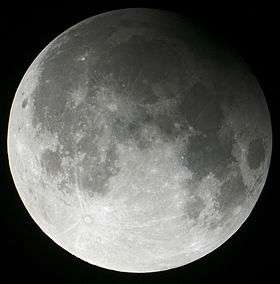May 2040 lunar eclipse
| Total lunar eclipse May 26, 2040 | |
|---|---|
Ecliptic north up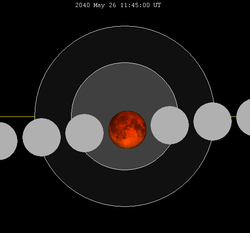 The moon will pass through the center of the Earth's shadow. | |
| Saros (and member) | 131 (35 of 72) |
| Gamma | |
| Duration (hr:mn:sc) | |
| Totality | |
| Partial | |
| Penumbral | |
| Contacts (UTC) | |
| P1 | |
| U1 | |
| U2 | |
| Greatest | |
| U3 | |
| U4 | |
| P4 | |
A total lunar eclipse will take place on May 26, 2040. The moon will pass through the center of the Earth's shadow.
Visibility
It will be completely visible over Australia and the Pacific, seen rising over Eastern Asia, and setting over North and South America.

Related lunar eclipses
Lunar year series (354 days)
This eclipse is the third of four lunar year eclipses occurring at the moon's ascending node.
The lunar year series repeats after 12 lunations or 354 days (Shifting back about 10 days in sequential years). Because of the date shift, the Earth's shadow will be about 11 degrees west in sequential events.
| Descending node | Ascending node | |||||
|---|---|---|---|---|---|---|
| Saros | Date Viewing |
Type Chart |
Saros | Date Viewing |
Type Chart | |
| 111 | 2038 Jun 17 |
Penumbral |
116 | 2038 Dec 11 |
Penumbral | |
| 121 | 2039 Jun 06 |
Partial |
126 | 2039 Nov 30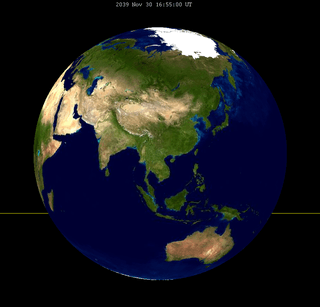 |
Partial | |
| 131 | 2040 May 26 |
Total |
136 | 2040 Nov 18 |
Total | |
| 141 | 2041 May 16 |
Partial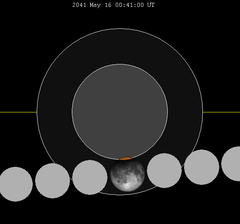 |
146 | 2041 Nov 08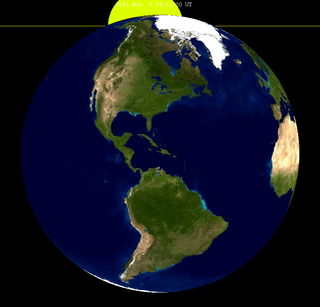 |
Partial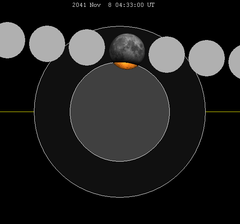 | |
| Last set | 2038 Jul 16 | Last set | 2038 Jan 21 | |||
| Next set | 2042 Apr 05 | Next set | 2042 Sep 29 | |||
Saros series
Lunar Saros series 131, has 72 lunar eclipses.
This eclipse series began in AD 1427 with a partial eclipse at the southern edge of the Earth's shadow when the Moon was close to its descending node. Each successive Saros cycle, the Moon's orbital path is shifted northward with respect to the Earth's shadow, with the first total eclipse occurring in 1950. For the following 252 years, total eclipses occur, with the central eclipse being predicted to occur in 2078. The first partial eclipse after this is predicted to occur in the year 2220, and the final partial eclipse of the series will occur in 2707. The total lifetime of the lunar Saros series 131 is 1280 years.
Because of the ⅓ fraction of days in a Saros cycle, the visibility of each eclipse will differ for an observer at a given fixed locale. For the lunar Saros series 131, the first total eclipse of 1950 had its best visibility for viewers in Eastern Europe and the Middle East because mid-eclipse was at 20:44 UT. The following eclipse in the series occurred approximately 8 hours later in the day with mid-eclipse at 4:47 UT, and was best seen from North America and South America. The third total eclipse occurred approximately 8 hours later in the day than the second eclipse with mid-eclipse at 12:43 UT, and had its best visibility for viewers in the Western Pacific, East Asia, Australia and New Zealand. This cycle of visibility repeats from the initiation to termination of the series, with minor variations.
| Greatest | First | |||
|---|---|---|---|---|
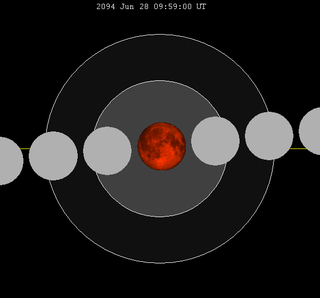 The greatest eclipse of the series will occur on 2094 Jun 28, lasting 102 minutes.[1] |
Penumbral | Partial | Total | Central |
| 1427 May 10 | 1553 July 25 | 1950 Apr 2 | 2022 May 16 | |
| Last | ||||
| Central | Total | Partial | Penumbral | |
| 2148 Jul 31 | 2202 Sep 3 | 2563 Apr 9 | 2707 Jul 7 | |
| 1914 Mar 12 | 1932 Mar 22 | 1950 Apr 2 | |||
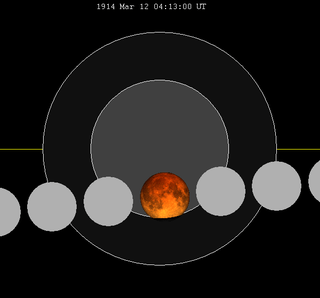 |
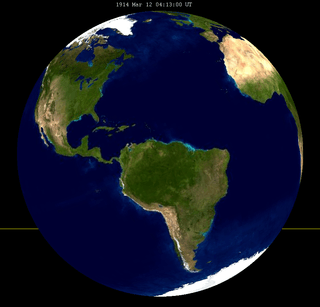 |
 |
 |
 |
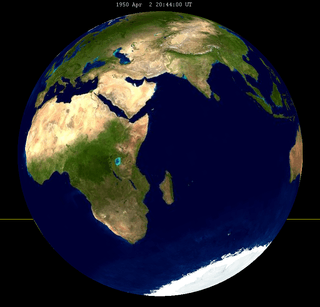 |
| 1968 Apr 13 | 1986 Apr 24 | 2004 May 4 | |||
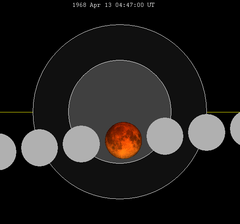 |
 |
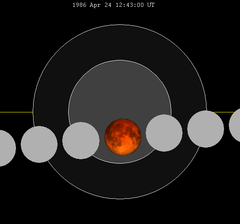 |
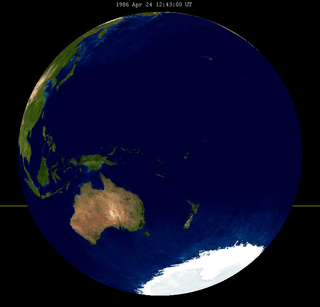 |
 |
 |
| 2022 May 16 | 2040 May 26 | 2058 Jun 6 | |||
 |
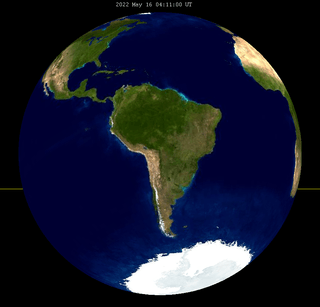 |
 |
 |
 |
 |
| 2076 Jun 17 | 2094 Jun 28 | ||||
 |
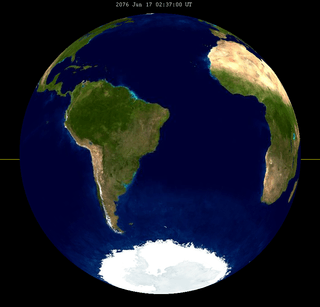 |
 |
 | ||
Inex series
The inex series repeats eclipses 20 days short of 29 years, repeating on average every 10571.95 days. This period is equal to 358 lunations (synodic months) and 388.5 draconic months. Saros series increment by one on successive Inex events and repeat at alternate ascending and descending lunar nodes.
This period is 383.6734 anomalistic months (the period of the Moon's elliptical orbital precession). Despite the average 0.05 time-of-day shift between subsequent events, the variation of the Moon in its elliptical orbit at each event causes the actual eclipse time to vary significantly.
All events in this series listed below and more are total lunar eclipses.
| Ascending node | Descending node | Ascending node | Descending node | ||||
|---|---|---|---|---|---|---|---|
| Saros | Date | Saros | Date | Saros | Date | Saros | Date |
| 96 | 1027 Apr 23 | 97 | 1056 Apr 2 | 98 | 1085 Mar 14 | 99 | 1114 Feb 21 |
| 100 | 1143 Feb 1 | 101 | 1172 Jan 13 | 102 | 1200 Dec 22 | 103 | 1229 Dec 2 |
| 104 | 1258 Nov 12 | 105 | 1287 Oct 22 | 106 | 1316 Oct 2 | 107 | 1345 Sep 12 |
| 108 | 1374 Aug 22 | 109 | 1403 Aug 2 | 110 | 1432 Jul 13 | 111 | 1461 Jun 22 |
| 112 | 1490 Jun 2 | 113 | 1519 May 14 | 114 | 1548 Apr 22 | 115 | 1577 Apr 2 |
| 116 | 1606 Mar 24 | 117 | 1635 Mar 3 | 118 | 1664 Feb 11 | 119 | 1693 Jan 22 |
| 120 | 1722 Jan 2 | 121 | 1750 Dec 13 | 122 | 1779 Nov 23 | 123 | 1808 Nov 3 |
| 124 | 1837 Oct 13 | 125 | 1866 Sep 24 | 126 | 1895 Sep 4 | 127 | 1924 Aug 14 |
| 128 | 1953 Jul 26 |
129 | 1982 Jul 6 |
130 | 2011 Jun 15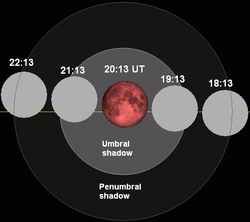 |
131 | 2040 May 26 |
| 132 | 2069 May 6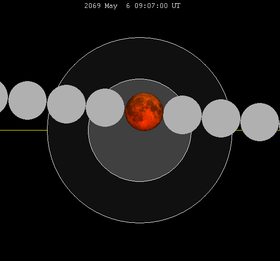 |
133 | 2098 Apr 15 |
134 | 2127 Mar 28 | 135 | 2156 Mar 7 |
| 136 | 2185 Feb 14 | 137 | 2214 Jan 27 | 138 | 2243 Jan 7 | 139 | 2271 Dec 17 |
| 140 | 2300 Nov 27 | 141 | 2329 Nov 7 | 142 | 2358 Oct 18 | 143 | 2387 Sep 28 |
| 144 | 2416 Sep 7 | 145 | 2445 Aug 17 | 146 | 2474 Jul 29 | ||
See also
Notes
External links
References
- Bao-Lin Liu, Canon of Lunar Eclipses 1500 B.C.-A.D. 3000, 1992
